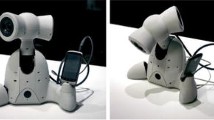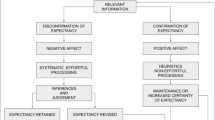Abstract
This paper explores how a robot’s physical presence affects human judgments of the robot as a social partner. For this experiment, participants collaborated on simple book-moving tasks with a humanoid robot that was either physically present or displayed via a live video feed. Multiple tasks individually examined the following aspects of social interaction: greetings, cooperation, trust, and personal space. Participants readily greeted and cooperated with the robot whether present physically or in live video display. However, participants were more likely both to fulfill an unusual request and to afford greater personal space to the robot when it was physically present, than when it was shown on live video. The same was true when the live video displayed robot’s gestures were augmented with disambiguating 3-D information. Questionnaire data support these behavioral findings and also show that participants had an overall more positive interaction with the physically present robot.
Similar content being viewed by others
References
Bainbridge WA, Hart J, Kim ES, Scassellati B (2008) The effect of presence on human-robot interaction. In: ROMAN 2008: Proceedings of the 17th IEEE international symposium on robot and human interactive communication, Munich, Germany, pp 701–706
Bickmore T, Cassell J (2001) Relational agents: a model and implementation of building user trust. In: CHI ’01: Proceedings of the SIGCHI conference on human factors in computing systems. ACM, New York, pp 396–403
Bickmore TW, Picard RW (2005) Establishing and maintaining long-term human-computer relationships. ACM Trans Comput-Hum Interact 12(2):293–327
Burgoon JK, Bonito JA, Bengtsson B, Cederberg C, Lundeberg M, Allspach L (2000) Interactivity in human-computer interaction: a study of credibility, understanding, and influence. Comput Hum Behav 16(6):553–574
Cassell J, Bickmore T, Billinghurst M, Campbell L, Chang K, Vilhjálmsson H, Yan H (1999) Embodiment in conversational interfaces: Rea. In: Proceedings of the CHI’99 conference. ACM Press, New York, pp 520–527
Goetz J, Kiesler S (2002) Cooperation with a robotic assistant. In: CHI ’02: CHI ’02 extended abstracts on human factors in computing systems. ACM, New York, pp 578–579
Hall ET (1966) The Hidden Dimension, 1st edn. Doubleday, Garden City
Hayduk LA (1981) The shape of personal space: An experimental investigation. Can J Behav Sci 13(1):87–93
Jung Y, Lee KM (2004) Effects of physical embodiment on social presence of social robots. Spain, pp 80–87
Kidd CD, Breazeal C (2004) Effect of a robot on user perceptions, vol 4, pp 3559–3564
Lee KM (2004) Presence, explicated. Commun Theory 14:27–50
Lombard M, Ditton T (1997) At the heart of it all: The concept of presence. J Comput Mediat Commun 3(2)
Lombard M, Ditton TB, Crane D, Davis B, Gil-Egui G, Horvath K, Rossman J (2000) Measuring presence: A literature-based approach to the development of a standardized paper-and-pencil instrument. Netherlands
Michel P, Gold K, Scassellati B (2004) Motion-based robotic self-recognition. In: Proceedings of 2004 IEEE/RSJ international conference on intelligent robots and systems, Japan
Powers A, Kiesler S, Fussell S, Torrey C (2007) Comparing a computer agent with a humanoid robot. In: HRI ’07: Proceedings of the ACM/IEEE international conference on human-robot interaction. ACM, New York, pp 145–152
Reeves B, Nass C (1996) The media equation: How people treat computers, video-displayed, and new media like real people and places. Center for the study of language and information
Rehnmark F, Bluethmann W, Mehling J, Ambrose RO, Diftler M, Chu M, Necessary R (2005) Robonaut: The ‘short list’ of technology hurdles. Computer 38(1):28–37
Shinozawa K, Naya F, Yamato J, Kogure K (2005) Differences in effect of robot and screen agent on human decision-making. Int J Hum-Comput Stud 62(2):267–279
Sidner C, Lee C, Kidd C, Lesh N, Rich C (2005) Explorations in engagement for humans and robots. Artif Intell 166(1–2):140–164
Steinfeld A, Jenkins OC, Scassellati B (2009) The oz of wizard: simulating the human for interaction research. In: HRI ’09: Proceedings of the 4th ACM/IEEE international conference on human robot interaction. ACM, New York, pp 101–108. doi:10.1145/1514095.1514115
Sun G, Scassellati B (2004) Reaching through learned forward model. In: Proceedings of 2004 IEEE-RAS/RSJ international conference on humanoid robots, CA
Takayama L, Pantofaru C (2009) Influences on proxemic behaviors in human-robot interaction. In: Proceedings of the 2009 IEEE/RSJ international conference on intelligent robots and systems, pp 5495–5502
Wainer J, Feil-Seifer DJ, Shell DA, Matarić MJ (2006) The role of physical embodiment in human-robot interaction. In: IEEE proceedings of the international workshop on robot and human interactive communication, Hatfield, UK, pp 117–122
Wainer J, Feil-Seifer D, Shell D, Mataric M (2007) Embodiment and human-robot interaction: A task-based perspective, pp 872–877
Walters M, Dautenhahn K, te Boekhorst R, Koay KKL, Kaouri C, Woods S, Nehaniv C, Lee D, Werry I (2005) The influence of subjects’ personality traits on personal spatial zones in a human-robot interaction experiment. In: IEEE international workshop on robot and human interactive communication. ROMAN 2005, pp 347–352
Woods SN, Walters ML, Koay KL, Dautenhahn K (2006) Methodological issues in hri: A comparison of live and video-based methods in robot to human approach direction trials. In: Proc 15th IEEE int symp on robot and human interactive communication, ROMAN 2006, pp 51–58
Yamato J, Brooks R, Shinozawa K, Naya F (2003) Human-robot dynamic social interaction. NTT Tech Rev 1(6):37–43
Author information
Authors and Affiliations
Corresponding author
Rights and permissions
About this article
Cite this article
Bainbridge, W.A., Hart, J.W., Kim, E.S. et al. The Benefits of Interactions with Physically Present Robots over Video-Displayed Agents. Int J of Soc Robotics 3, 41–52 (2011). https://doi.org/10.1007/s12369-010-0082-7
Accepted:
Published:
Issue Date:
DOI: https://doi.org/10.1007/s12369-010-0082-7




